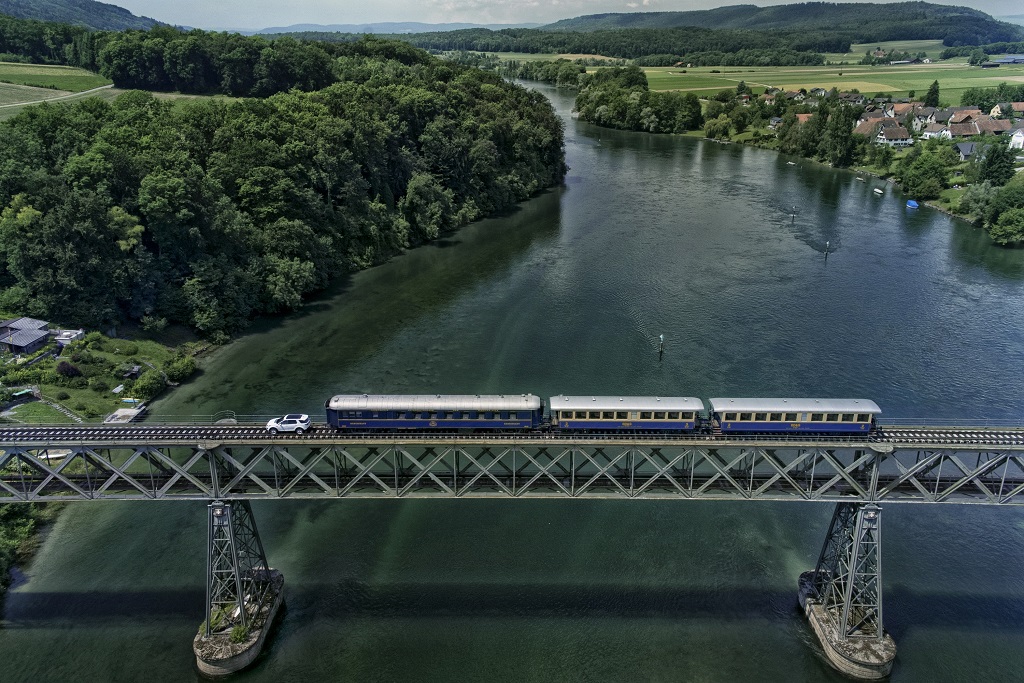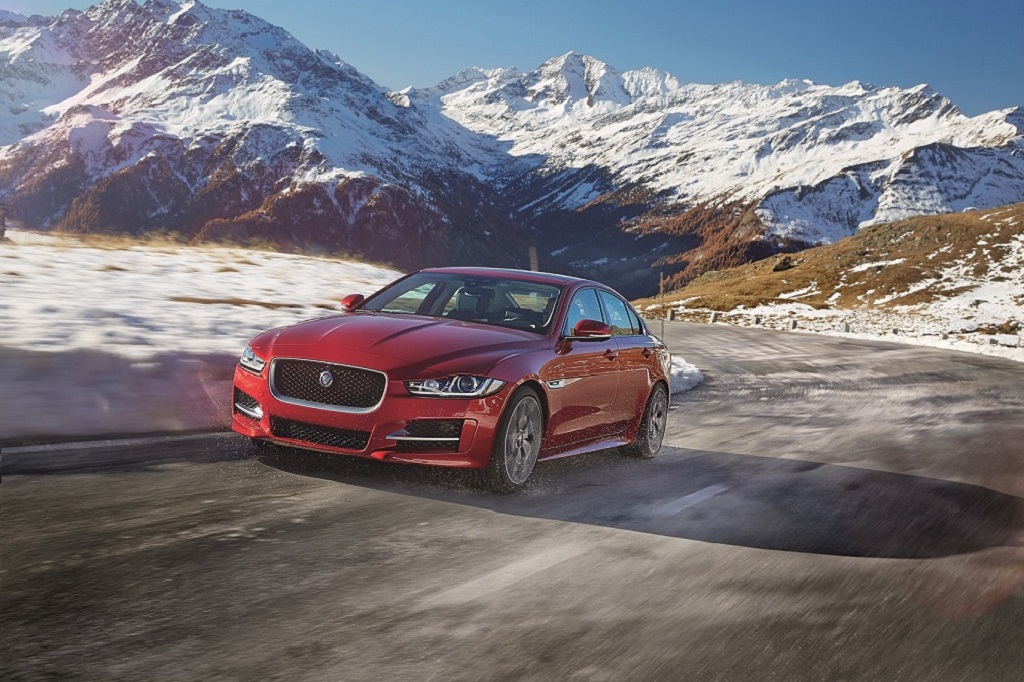- Land Rover Discovery Sport tows train 60 times own weight in100-tonne train tow; equivalent to the weight of a Boeing-757 airplane
- Dramatic stunt performed on 85ft high bridge demonstrates vehicle’s impressive towing capacity, semi-autonomous driving technologyand powerful 180PS Ingenium diesel engine
Land Rover stopped people in their tracks today as the Discovery Sport SUV towed three luxury train carriages weighing more than 100 tonnes along a railway tracking a demonstration of towing capability.
The 10km journey through the Rhine region of northern Switzerland putthe compact Discovery Sport’s pulling power to the ultimate test. Though the Discovery Sport has a certified maximum towing weight of 2,500kg (2.5 tonnes), itwas able to pull 60 times its own weight, powered by Jaguar Land Rover’s 180PS Ingenium diesel engine providing 430Nm of torque. In addition, the Discovery Sport benefitted from Land Rover’s portfolio of towing and traction technologies such as Terrain Response, Tow Assist, Tow Hitch Assist and All Terrain Progress Control – a semi-autonomous off-road driving system that automatically manages engine output and braking, to complete the stunt.
The stunt was designed by Land Rover engineers to clearly show the strength and capability of the Discovery Sport, echoing a similar feat performed in 1989 for the launch of its ancestor, Discovery I.
Karl Richards, Lead Engineer for Stability Control Systems at Jaguar Land Rover, said: “Towing is in Land Rover’s DNA, and Discovery Sport is no exception. Over the years, we have introduced game-changing towing technologies to take the stress out of towing for our customers. I’ve spent most of my career travelling to the most punishing parts of the world to test Land Rovers in grueling conditions, yet this is the most extreme towing test I’ve ever done.”
The vehicle’s drive train remained unchanged; the only modification being the fitment of rail wheels by specialists Aquarius Railroad Technologies, to act as ‘stabilisers’. Unlike the 1989 Discovery tow, Discovery Sport completed the impressive pull without the aid of low-range gears, instead using its state-of-the-art 9-speed automatic gearbox and Terrain Response technology to generate the necessary traction. Land Rover’s All Terrain Progress Control (ATPC) system was also engaged at the press of a button during the tow, to maximisetraction at a set speed. Acting much like a ‘low-speed cruise control’, ATPC allows the driver to focus on the road – or in this case the railway – ahead.
The train-pulling feat was undertaken on 10km of track at the Museumsbahn Stein am Rhein in Switzerland, crossing the River Rhine on the dramatic Hemishofen bridge – a historic steel span measuring 935 feet long and soaring 85 feet above the valley floor.
Land Rover has a history of rail conversions, from the days of the Series IIand IIALand Roverto the various Defender models that have been modified to run on rails for maintenance, and the notable launch of Discovery I in 1989. The latter saw a converted Discovery towing a series of carriages in Plymouth to demonstrate the capability of the new 200Tdi diesel engine.
British road-to-rail 4×4 conversion specialists Aquarius Railroad Technologies fitted the rail wheels to the otherwise standard Discovery Sport. Managing Director James Platt, said: “For a vehicle of this size to pull a combined weight of more than 100 tonnes demonstrates real engineering integrity. No modifications were necessary to the drive train whatsoever and in tests the Discovery Sport generated more pull than our road-rail Defender, which is remarkable.”
Click here to see the Discovery Sport towing a train across the Hemishofen bridge: https://youtu.be/l8rQEQAeET8
Land Rover Discovery Sport
The Discovery Sport is the first member of Land Rover’s new Discovery familyand was awarded a Five Star Euro NCAP rating at launch. Since going on sale in December 2014, the Discovery Sport has retailed over 123,300 vehicles and was Land Rover’s best-seller for the month of May retailing an impressive 10,075 vehicles.
All-terrain capability
The capability of the Discovery Sport is heightened by the introduction of All Terrain Progress Control (ATPC). ATPC is an advanced system that enables drivers to set and maintain a steady speed in off-road conditions. Developed by Land Rover’s industry-leading all-terrain specialists, ATPC functions similarly to a cruise control system, operational between 2km/h and 30km/h. ATPC also features a dedicated Launch feature, allowing the vehicle to pull away smoothly and easily, even on problematic low-friction surfaces like ice, snow or wet grass.
Efficient power trains
Jaguar Land Rover’s cutting-edge Ingenium 2.0-litre diesel engine ensures Discovery Sport is one of the most efficient premium compact SUVs in the world.
The EU6 compliant dieselis available with two power outputs – 150PS and 180PS, delivering fuel economy of up to 57.7mpg (4.9l/100km) and CO2 emissions from 129g/km. The powerful 180PS engine has a top speed of 117 mph (188 km/h) and can accelerate from 0-100km/h in just 8.9 seconds*.
Customers of the Discovery Sport can also choose the four-cylinder turbocharged petrol engine. The 2.0-litre petrol with 240PS and direct fuel injection offers six-cylinder levels of performance in a compact package that reduces weight and cuts CO2 emissions by up to 20 per cent, compared to conventional larger capacity engines with a similar power output.
All engine derivatives specified with the nine-speed automatic gearbox are fitted with paddleshift controls, allowing the driver to manually select each gear for added control during towing or in challenging off-road and dynamic on-road scenarios.
The premium compact Discovery Sport SUV is sold in over 170 markets and manufactured at Jaguar Land Rover’s award-winning Halewood plant in the UK.



